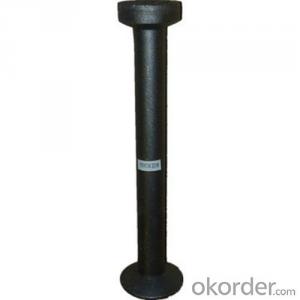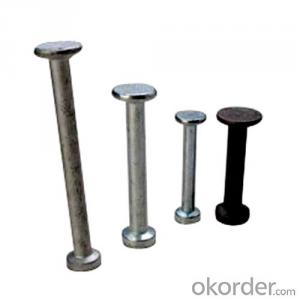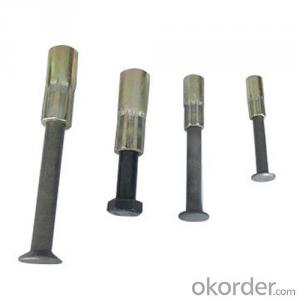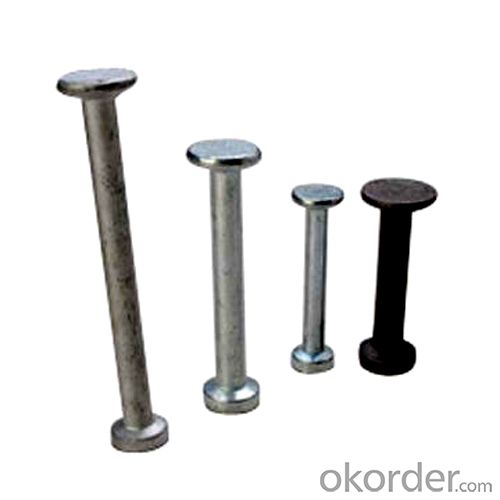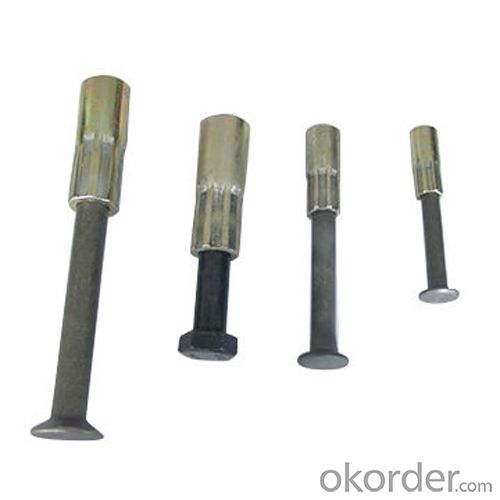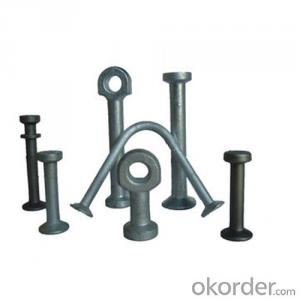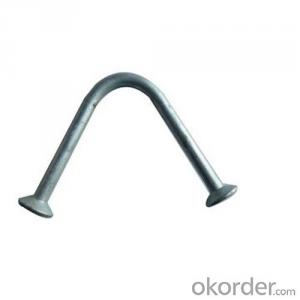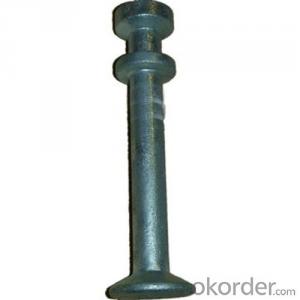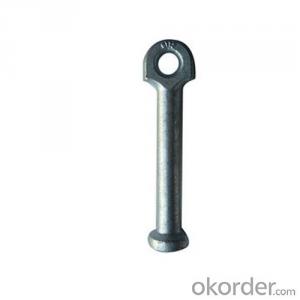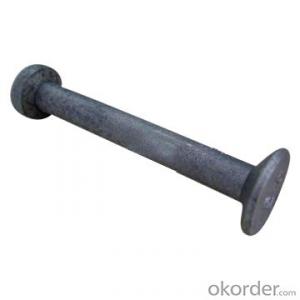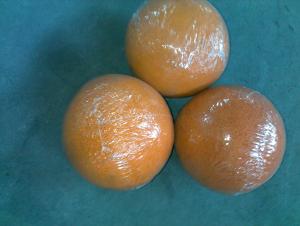Lifting Anchor Forged Straight Type Long Design
- Loading Port:
- Tianjin
- Payment Terms:
- TT OR LC
- Min Order Qty:
- 100 pc
- Supply Capability:
- 10000 pc/month
OKorder Service Pledge
OKorder Financial Service
You Might Also Like
1. Specification:
Material: Carbon Steel, Forged
Finish: Self Colored, or Galvanized
Packaging: carton, then on pallets, or as customers' requirements
Stocks: we have stocks for regular sizes
Warning: never exceed working load limit
2. Products available:
Swift lift lifting eyes are used with the swift lift anchors to lift, handle and place precast concrete elements
3. Primary competitive advantages:
1. More than 10 years 4 years focus on building material manufacturing
Prompt delivery lead time within 25 days after confirming order
2. Eathu's products are enhanced by the factory QA and quality control checks during the production, if necessary each order can be send out with a certificate referring back to test
3. OEM/ODM capability: more then 10 years experience
4.Packaging and delivery:
Packaging details: goods packed in cartons and then on the pallet
Delivery detail: within 25 days after getting payment
Small Orders Accepted
Brand-name Parts
Country of Origin
Distributorships Offered
Electronic Link
Experienced Staff
Form A
Green Product
Guarantee/Warranty
International Approvals
Market:
Mid East/Africa
North America
Western Europe
FAQ:
Q1: How long about delivery time Concrete Lifting anchors ?
A1: The delivery time will be very short, normally we keep the raw materials for old customers and sometime we also keep stock products to
make sure delivery time in any emergency cases.
Q2: How do we guarantee the quality of our Concrete lifting anchors?
A2: We have established an advanced quality management system which conducts strict quality tests at every step, from raw materials to the final product. At the same time, we provide extensive follow-up service assurances as required.
Q3: How soon can we receive the product after purchase?
A3: Within three days of placing an order, we will book the vessel for goods. The specific shipping date is dependent upon international and government factors, but is typically 7 to 30 workdays.
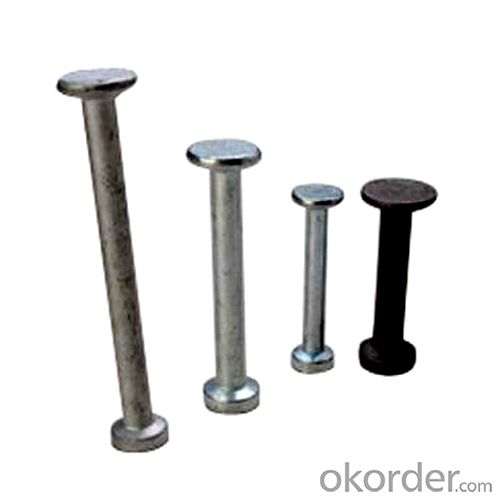
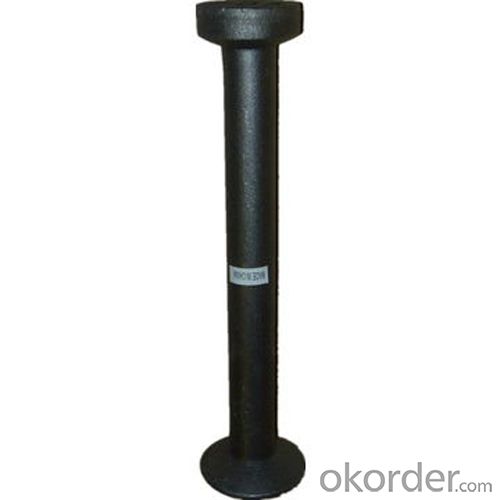
- Q: Are there any specific recommendations for the inspection and testing of concrete pump spare parts?
- Yes, there are specific recommendations for the inspection and testing of concrete pump spare parts. Firstly, it is important to visually inspect the spare parts for any signs of damage, such as cracks, dents, or excessive wear. This can be done by carefully examining the parts and looking for any irregularities or abnormalities. Next, it is recommended to conduct non-destructive testing (NDT) to ensure the integrity and quality of the spare parts. NDT methods such as ultrasonic testing, magnetic particle testing, or dye penetrant testing can be used to detect any hidden defects or flaws in the parts. These tests can help identify potential issues that may affect the performance or safety of the concrete pump. In addition, it is advisable to check the dimensions and tolerances of the spare parts to ensure they meet the manufacturer's specifications. This can be done using precision measuring tools and comparing the measurements with the required specifications. Any deviations should be noted and addressed accordingly. Furthermore, functional testing should be conducted to ensure the spare parts are operating as intended. This can involve installing the parts in the concrete pump and carrying out various tests to verify their functionality and performance. For example, the pump can be tested for its flow rate, pressure, and efficiency to ensure optimal performance. Lastly, it is crucial to follow the manufacturer's guidelines and recommendations for the inspection and testing of concrete pump spare parts. These guidelines may provide specific instructions and procedures for inspecting and testing each type of spare part, ensuring that they are done accurately and safely. It is important to consult the manufacturer's documentation and seek professional advice if needed.
- Q: Can concrete pump spare parts be heat-treated or hardened for increased durability?
- Concrete pump spare parts can undergo heat treatment or hardening to increase their durability. By subjecting the parts to controlled heating and cooling processes, their mechanical properties can be altered. This alteration significantly improves their hardness, strength, and wear resistance, thus enhancing their durability and ability to withstand harsh operating conditions. Various heat treatment methods, such as quenching and tempering, induction hardening, and case hardening, can be applied to different types of spare parts, including cylinders, pistons, wear plates, and delivery pipes. These processes contribute to the overall performance and lifespan of the spare parts, ensuring their ability to withstand the demanding nature of concrete pumping operations.
- Q: How do I properly maintain and replace hydraulic valves in concrete pump spare parts?
- Proper maintenance and replacement of hydraulic valves in concrete pump spare parts involve a few key steps. Firstly, it is crucial to regularly inspect the valves for any signs of wear, damage, or leakage. This can be done by checking the valve body, seals, and connections. Secondly, ensure that the valves are lubricated according to the manufacturer's recommendations to prevent friction and extend their lifespan. Additionally, it is essential to adhere to the specified pressure and temperature limits during operation, as exceeding these limits can lead to valve failure. When it comes to replacement, it is recommended to consult the equipment manual or seek professional assistance to ensure that the correct valves are selected and installed accurately. Regular maintenance and timely replacement of hydraulic valves will ensure the optimal performance and longevity of the concrete pump spare parts.
- Q: How often should a hopper filter be cleaned or replaced?
- The cleaning or replacement frequency of a hopper filter relies on various factors such as hopper type, contaminant nature, and usage pattern. It is generally suggested to clean or replace the hopper filter every three to six months. However, if the hopper operates in a dusty or dirty environment, or deals with materials generating abundant debris, more frequent cleaning or replacement might be necessary. Regular examination of the hopper filter is vital to assess particle accumulation and filtration efficiency. Additionally, if the hopper filter displays signs of damage or wear, immediate replacement is essential to maintain peak performance and prevent potential contamination. Ultimately, it is advisable to consult the manufacturer's guidelines and recommendations for the specific hopper filter in use.
- Q: What are some common issues with concrete pump pipes and how can they be prevented?
- Some common issues with concrete pump pipes include blockages, leaks, and wear and tear. These issues can be prevented by following proper maintenance and operational practices. 1. Blockages: Blockages occur when concrete hardens inside the pipe, hindering the flow. To prevent blockages, it is important to regularly clean the pipes after each use. Flushing the pipes with water or using a high-pressure air hose can remove any residual material and prevent build-up. Additionally, using concrete mixtures with proper consistency and avoiding excessive use of additives can reduce the likelihood of blockages. 2. Leaks: Leaks can occur due to cracks or gaps in the pipe, causing concrete to seep out. Regular inspection of the pipes is crucial to identify any signs of damage or wear. Repairing or replacing damaged sections promptly can prevent leaks. It is also essential to use high-quality pipes that are resistant to abrasion and chemical corrosion, as they are less prone to developing leaks. 3. Wear and Tear: Concrete pump pipes are subjected to significant stress and abrasion during operation. Over time, this can lead to wear and tear, resulting in weakened pipes or even breakages. To prevent excessive wear, it is important to use pipes made from durable materials such as hardened steel or composite materials. Regularly inspecting the pipes for signs of wear, such as thinning or deformation, and replacing them as needed can help prevent sudden failures. 4. Pipe movement and alignment issues: Concrete pump pipes can shift or become misaligned during operation, leading to reduced efficiency and potential damage. To prevent this, ensure that the pipes are securely fastened to the pump and properly aligned. Using clamps and brackets or employing anti-vibration measures can help maintain the stability and alignment of the pipes during pumping operations. 5. Operator errors: Improper handling and operation can also contribute to issues with concrete pump pipes. Operators should be adequately trained in operating the pump and handling the pipes. Following recommended operating procedures, avoiding excessive pressure or flow rates, and being cautious while maneuvering the pipes can prevent unnecessary strain and damage to the pipes. Overall, proactive maintenance, proper handling, and selecting high-quality pipes can significantly reduce common issues with concrete pump pipes, ensuring smooth and efficient concrete pumping operations.
- Q: Which height of concrete pump is the most practical?
- The power of the concrete pump truck engine power is transmitted to the hydraulic pump or rear axle through the power transfer case, push the piston to drive the hydraulic pump concrete pump
- Q: What is the purpose of a concrete pump cleaning ball?
- To effectively cleanse and eliminate any lingering concrete or debris inside a concrete pump system, a concrete pump cleaning ball serves its purpose. These cleaning balls are specifically designed for insertion into the pumping system and subsequent propulsion through the pipes using water pressure or compressed air. As they progress through the system, the cleaning balls effectively scrape away any solidified concrete or accumulation, guaranteeing unobstructed flow and optimal performance of the pump and pipes. This routine cleaning process not only prevents blockages and upholds pump efficiency but also prolongs the equipment's lifespan. Furthermore, the utilization of cleaning balls ensures that the subsequent batch of pumped concrete remains uncontaminated by any residual debris, resulting in a superior final product.
- Q: Do concrete pump spare parts come with a warranty?
- Certainly, a warranty is provided for concrete pump spare parts. The duration of the warranty may differ depending on the manufacturer and the specific part being acquired. Typically, well-established manufacturers and suppliers offer warranties on their spare parts to instill confidence in customers regarding the product's quality and dependability. It is crucial to thoroughly examine the warranty's terms and conditions to comprehend the coverage and duration. Should any flaws or complications arise within the warranty period, customers can usually obtain a replacement or have the part repaired without incurring any additional expenses.
- Q: Can I get spare parts for concrete pump hoppers and agitators?
- Yes, it is possible to get spare parts for concrete pump hoppers and agitators. Many manufacturers and suppliers of concrete pumps and equipment offer spare parts for their products. You can contact the manufacturer or supplier of your specific concrete pump hopper or agitator to inquire about the availability and pricing of spare parts. Additionally, there are also specialized companies that provide spare parts for various brands and models of concrete pumps and equipment. These companies typically have a wide range of spare parts in stock and can ship them to you as needed.
- Q: What are the key considerations when purchasing spare parts for a concrete pump?
- When purchasing spare parts for a concrete pump, the key considerations include ensuring compatibility with the specific make and model of the pump, quality and durability of the parts, availability and delivery time, cost-effectiveness, and the reputation and reliability of the supplier.
Send your message to us
Lifting Anchor Forged Straight Type Long Design
- Loading Port:
- Tianjin
- Payment Terms:
- TT OR LC
- Min Order Qty:
- 100 pc
- Supply Capability:
- 10000 pc/month
OKorder Service Pledge
OKorder Financial Service
Similar products
Hot products
Hot Searches
Related keywords
